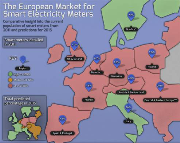 Supplier of smart grid and metering technology, Sentec, has revealed that despite the hype, few regions in Europe have made significant progress in rolling-out smart meters – yet things may look very different by 2015.
Supplier of smart grid and metering technology, Sentec, has revealed that despite the hype, few regions in Europe have made significant progress in rolling-out smart meters – yet things may look very different by 2015.
Sentec has produced a heat map based on 2011 data from IMS Research on the roll-out to date and their predictions for 2015.
Italy and the Nordics are currently leading the pack with over 94% and 70% of meters installed respectively, due in large part to early investment ($3bn by 2006) in smart meter technology by Enel in Italy and the first policy of regulation driven roll-out of smart meters in Sweden. IMS’s predictions for 2015 show France (49%), Spain and Portugal (73%) and the UK and Ireland (65%) catching up. However, there is uncertainty on whether the UK will reach its potential this fast.
“The deregulated structure of the UK market is uniquely challenging for rapid and coordinated action in a large scale initiative like this and we believe that smart meter deployment in 65% of UK homes by 2015 is not possible,” said Mark England, Sentec’s CEO. “There is a great deal of work still to do to finalise the technical and regulatory framework for smart metering.”
Elsewhere, the map shows that the roll-out wheels are well and truly in motion with western and northern Europe expecting to see over 70% penetration by 2015, based on IMS’s data. Lagging behind with less than 30% penetration by 2015 are Germany and Poland.
Mark England continued, “The heat map highlights that the roll-out is at defining moment. As a result, the industry has a unique window of opportunity to ensure that the right specification and roll-out decisions are made. The decision by Enel to design and build their smart meters has meant that they have an exact match to their operational requirements at a favourable cost point and it may benefit other utilities to follow their example.
“To make the most of that approach, it’s crucial that energy companies across Europe are thinking not only about what smart meters need to deliver now, but what they might need to deliver in the future. Only then can smart meters deliver the benefits consumers expect over the next ten years.”



